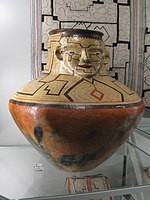| Shipibo-Conibo | |
|---|---|
| Native to | Peru |
| Region | Ucayali Region |
| Ethnicity | Shipibo-Conibo people |
Native speakers | 26,000 (2003)[1] |
Panoan
| |
| Language codes | |
| ISO 639-3 | Either:shp – Shipibo-Conibokaq – Tapiche Capanahua |
| Glottolog | ship1253 |
 | |
Shipibo (also Shipibo-Conibo, Shipibo-Konibo) is a Panoan language spoken in Peru and Brazil by approximately 26,000 speakers. Shipibo is a recognized indigenous language of Peru.

Shipibo has three attested dialects:
Extinct Xipináwa (Shipinawa) is thought to have been a dialect as well,[3] but there is no linguistic data.

| Front | Central | Back | |
|---|---|---|---|
| Close | i ĩ ⟨i⟩ | ɯ ɯ̃ ⟨e⟩ | |
| Mid | o õ ⟨o⟩ | ||
| Open | a ã ⟨a⟩ |
| Labial | Dental/ Alveolar |
Retroflex | Palato- alveolar |
Dorsal | Glottal | ||
|---|---|---|---|---|---|---|---|
| Nasal | m ⟨m⟩ | n ⟨n⟩ | |||||
| Plosive | p ⟨p⟩ | t ⟨t⟩ | k ⟨c/qu⟩ | ||||
| Affricate | ts ⟨ts⟩ | tʃ ⟨ch⟩ | |||||
| Fricative | voiceless | s ⟨s⟩ | ʂ ⟨s̈h⟩ | ʃ ⟨sh⟩ | h ⟨j⟩ | ||
| voiced | β ⟨b⟩ | ||||||
| Approximant | w ⟨hu⟩ | ɻ ⟨r⟩ | j ⟨y⟩ | ||||